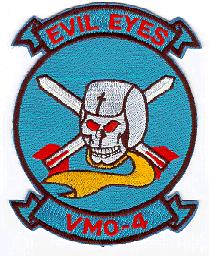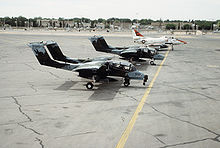| Marine Unmanned Aerial Vehicle Squadron 4 | |
|---|---|
 VMU-4 squadron insignia | |
| Active |
As VMO-4:
|
| Country | United States of America |
| Branch | |
| Type | Aerial reconnaissance |
| Role | Reconnaissance, Surveillance, and Target Acquisition |
| Size | TBD |
| Part of | MAG-41, 4th MAW |
| Garrison/HQ | Marine Corps Air Station Camp Pendleton |
| Nickname(s) | Evil Eyes |
| Tail Codes |
7Y(1st) 5Y(2nd) MU(3rd) |
| Engagements |
Battle of Saipan Battle of Iwo Jima |
| Aircraft flown | |
| Multirole helicopter | SH-34G/J Sea Bat |
| Reconnaissance |
OY-1 Grasshopper OV-10 Bronco RQ-7B Shadow |
Marine Unmanned Aerial Vehicle Squadron 4 (VMU-4) is an unmanned aerial vehicle (UAV) squadron in the United States Marine Corps that operates the RQ-21 Blackjack. It is the fourth UAV squadron in the Marine Corps and the first in the reserve component. The squadron, nicknamed the "Evil Eyes", entered the force structure on 1 July 2010, when Marine Observation Squadron 4 (VMO-4) was reactivated and redesignated VMU-4.
The squadron inherited the history of VMO-4 which was an observation squadron that saw extensive action during World War II. They were last based at Naval Air Station Atlanta near Atlanta, Georgia and were deactivated on 23 May 1993 as part of the post- Cold War drawdown of forces. VMU-4 is a subordinate unit of Marine Aircraft Group 41 and the 4th Marine Aircraft Wing.
Mission
Provide aerial fire support spotting and intelligence in support of the Marine Air-Ground Task Force.
History
World War II
The squadron was originally activated as Artillery Spotting Division (Marine Observation Squadron 951) (ASD(VMO-951)) on 20 December 1943 at Marine Corps Air Station Quantico, Virginia. [1] This happened because the Marine Corps' field artillery school was located at Marine Corps Base Quantico. [2] Less than a month later they were redesignated as Marine Observation Squadron 4 (VMO-4) as they trained to fly the OY-1 Grasshopper. The squadron would later move to San Diego, California and the deploy overseas to Marine Corps Air Station Ewa in Hawaii for further training where they would be assigned to support the V Amphibious Corps. In April 1944 they were sent to Maui for duty with the 4th Marine Division and on 29 May 1944 they left Pearl Harbor for their first combat mission. [1]
The first two planes from VMO-4 landed on Charan-Kanoa airstrip during the Battle of Saipan on 17 June 1944 and began operating immediately. [1] Six days later all squadron gear and personnel were ashore and the squadron shifted operations to Aslito Field. During the battle they their mission was to conduct tactical reconnaissance for ground troops and direct artillery and naval gunfire strikes. [3] VMO-2 was the only other similar squadron to fly during the invasion of Saipan. [4] Two months later two planes from the squadron would assist their fellow Marines during the week-long Battle of Tinian. During these two battles, the squadron flew 400 sorties and suffered 2 pilots killed. One after he crash landing after getting hit by enemy fire and another over Tinian. The Ground echelon of the squadron suffered 3 dead and 9 wounded during an enemy air raid. [5] On 10 August 1944 the squadron set sail for Pearl Harbor to rest and refit. [1]

VMO-4 personnel and gear remained in Hawaii until January 1945 when they set sail for Guam. While in Guam they received new aircraft and which were then flown to Saipan to be loaded upon escort carriers for movement to their next mission, the Battle of Iwo Jima. The squadron waited offshore to support Marines on the ground at Iwo until two planes from the USS Wake Island (CVE-65) were able to land at the airstrip on 26 February 1945. These were the first two aircraft to land on the newly captured airstrip and they did so while still under heavy small-arms and mortar fire. In time the mere presence of these small planes overhead would influence Japanese gunners to cease fire and button up against the inevitable counter-battery fire to follow. Often the pilots would undertake pre-dawn or dusk missions simply to extend this protective "umbrella" over the troops, risky flying given Iwo's unlit fields and constant enemy sniping from the adjacent hills. [6] During the battle the squadron would fly 204 sorties in 19 days totaling 366.4 hours of flying. This would leave Six of the seven planes used so badly damaged that they were scrapped afterwards. [7] After the battle they returned to Maui in April 1945 where they would remain until the end of the war.
Following the surrender of Japan, the squadron returned to San Diego, California where they were deactivated on 21 October 1945.
Cold war years
VMO-4 was reactivated on September 1, 1962 at Naval Air Station Grosse Ile, Michigan, from the personnel of HMR-761 and HMR-773, which had recently decommissioned. [8] VMO-4 flew SH-34G/Js until November 1968, when the squadron became the first squadron in the reserves to receive the OV-10As. [9]

The squadron later relocated to Naval Air Station Atlanta during July 1976. The squadron was called to active service during the Gulf War time-period and become part of Marine Aircraft Group 29 at Marine Corps Air Station Cherry Point, North Carolina however it did not deploy overseas. The squadron was decommissioned on March 31, 1994 as part of the general drawdown of US forces following the end of the Cold War.
Reactivation as VMU-4
The squadron was reactivated on 1 July 2010 and redesignated Marine Unmanned Aerial Vehicle Squadron 4 (VMU-4). VMU-4 is a subordinate unit of Marine Aircraft Group 41, 4th Marine Aircraft Wing.
VMU-4's first flight with the RQ-7B Shadow was 29 September 2010 in Yuma, AZ.
VMU-4 is now currently stationed at Camp Pendleton, California. They moved to Camp Pendleton officially on 22 February 2013.
Scheduled Deactivation
The squadron deactivated in the Summer of 2021
Unit awards
| Streamer | Award | Year(s) | Additional Info |
|---|---|---|---|
|
|
Presidential Unit Citation Streamer | 14 June-1 August 1944; 19–28 Feb 1945 | Saipan; Iwo Jima (pilots and observers only) |
|
|
Joint Meritorious Unit Award Streamer | ||
|
|
Navy Unit Commendation Streamer | 19–28 February 1945 | Iwo Jima(ground echelon only) |
|
|
Meritorious Unit Commendation Streamer with one Bronze Star | ||
|
|
Asiatic-Pacific Campaign Streamer with two Bronze Stars | Saipan, Iwo Jima | |
|
|
World War II Victory Streamer | 1941–1945 | Pacific War |
|
|
National Defense Service Streamer | 1990–1995 | Gulf War |
See also
- United States Marine Corps Aviation
- Organization of the United States Marine Corps
- List of active United States Marine Corps aircraft squadrons
- List of decommissioned United States Marine Corps aircraft squadrons
- History of unmanned aerial vehicles
Notes
- ^ a b c d Sherrod (1952), p.453.
- ^ Shettle (2001), p.131.
- ^ Rottman (2002), p.406.
- ^ Chapin, John (1994). "Breaching the Marianas: The Battle for Saipan". Marines in World War II Commemorative Series. Marine Corps Historical Center. Retrieved 16 April 2009.
- ^ Sherrod (1952), p.252.
- ^ Alexander, Joseph H. (1994). "Closing in: Marines in the Seizure of Iwo Jima". Marines in World War II Commemorative Series. Marine Corps Historical Center. Retrieved 16 April 2009.
- ^ Sherrod (1952), p.349.
- ^ VMO-4 CO letter to Historical Division, HQMC, 26 May 1963
- ^ ""Bronco" Packs Deadly Wallop". The Reserve Marine. Washington, D.C. March 1969. Retrieved 2 January 2022.
References
- Bibliography
- Rottman, Gordon L. (2002). U.S. Marine Corps World War II Order of Battle – Ground and Air Units in the Pacific War, 1939 – 1945.. Greenwood Press. ISBN 0-313-31906-5.
- Sherrod, Robert (1952). History of Marine Corps Aviation in World War II. Washington, D.C.: Combat Forces Press. OCLC 1261876.
- Shettle Jr., M. L. (2001). United States Marine Corps Air Stations of World War II. Bowersville, Georgia: Schaertel Publishing Co. ISBN 0-9643388-2-3.
- Web
- U.S. Marine Corps Broncos – VMO-2
- Cpl Hazard, Austin (8 July 2010). "New Marine Unmanned Aircraft Unit Stationed at Yuma Air Station". United States Marine Corps.
- Cpl Hazard, Austin (30 September 2010). "VMU-4 Casts Shadow Over Yuma". United States Marine Corps.
- LCpl Diamant, Aaron (21 April 2011). "VMU-4 Serves as Eye in Yuma Sky for WTI". United States Marine Corps.
- "National Guard and Reserve Equipment Report for FY12" (PDF). Department of Defense. February 2011.
- Gilbert, James (29 September 2010). "First MCAS flight of unmanned aerial vehicle". Yuma Sun.
- Mortimer, Gary (3 November 2011). "Yuma's eyes in the sky: Unmanned Aerial Vehicle 4 nearing full operational status". sUAS News.
